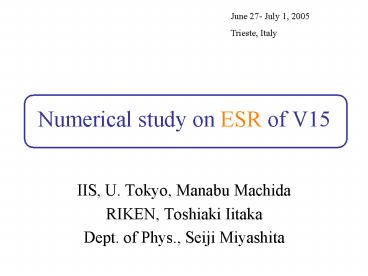Numerical study on ESR of V15 - PowerPoint PPT Presentation
1 / 19
Title:
Numerical study on ESR of V15
Description:
June 27- July 1, 2005 Trieste, Italy Numerical study on ESR of V15 IIS, U. Tokyo, Manabu Machida RIKEN, Toshiaki Iitaka Dept. of Phys., Seiji Miyashita – PowerPoint PPT presentation
Number of Views:112
Avg rating:3.0/5.0
Title: Numerical study on ESR of V15
1
Numerical study on ESR of V15
June 27- July 1, 2005 Trieste, Italy
- IIS, U. Tokyo, Manabu Machida
- RIKEN, Toshiaki Iitaka
- Dept. of Phys., Seiji Miyashita
2
Nanoscale molecular magnet V15
A. Mueller and J. Doering (1988)
Vanadiums provide fifteen 1/2 spins.
(http//lab-neel.grenoble.cnrs.fr/)
3
Hamiltonian and Intensity
4
The parameter set
H. De Raedt, et al., PRB 70 (2004) 064401
M. Machida, et al., JPSJ (2005) suppl.
5
Difficulty
difficult!
Direct diagonalization requires memory of
Its computation time is of (e.g. S. Miyashita
et al. (1999))
6
Two numerical methods
- The double Chebyshev expansion method (DCEM)
- - speed and memory of O(N)
- - all states and all temperatures
- The subspace iteration method (SIM)
- - ESR at low temperatures.
7
DCEM
8
ESR absorption curves
DCEM
Typical calculation time for one absorption curve
is about half a day.
9
Background of DCEM
The DCEM a slight modification of the
Boltzmann-weighted time-dependent method (BWTDM).
T. Iitaka and T. Ebisuzaki, PRL (2003)
Making use of the random vector technique
and the Chebyshev polynomial expansion
10
DCEM (1)
Random phase vector
11
DCEM (2)
Chebyshev expansions of the thermal and
time-evolution operators.
small w
12
Temperature dependence of intensity
Our calculation
Experiment
Y.Ajiro et al. (2003)
13
SIM
14
ESR at low temperatures by SIM
Intensity ratio
We consider the lowest eight levels.
15
Temperature dependence of R(T)
With DM
Without DM
16
Triangle model analysis
17
Energy levels with weak DM
18
Intensity ratio of triangle model
At zero temperature
19
Summary
O(N) algorithms for the Kubo formula DCEM
- Random vector and Chebyshev polynomials
ESR of V15
- High to low temperatures by DCEM
- Ultra-cold temperature by SIM
- Triangle model analysis
M. Machida, T. Iitaka, and S. Miyashita, JPSJ
(2005) suppl. (cond-mat/0501439)

